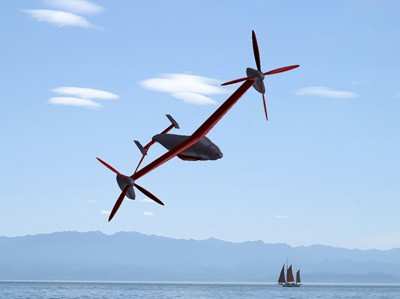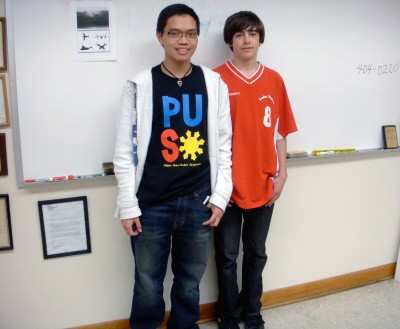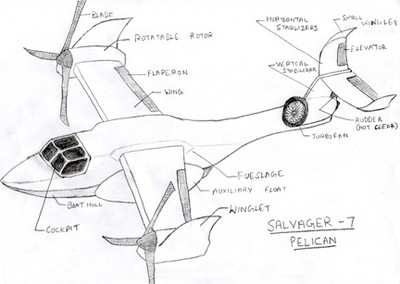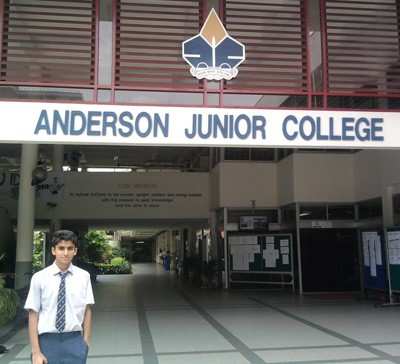Students Apply Science And Imagination In NASA Tilt-Rotor
Design Contest
 So how many times did you sit in a high-school class that was,
shall we say, less than compelling and sketch ideas for new
airplanes? Well, some helicopters of the future will look very
different from today's, at least as imagined by high school
students for a NASA aeronautics competition, and these aren't idle
daydreams.
So how many times did you sit in a high-school class that was,
shall we say, less than compelling and sketch ideas for new
airplanes? Well, some helicopters of the future will look very
different from today's, at least as imagined by high school
students for a NASA aeronautics competition, and these aren't idle
daydreams.
NASA challenged students to write a paper about a civilian
aircraft that could hover, rescue up to 50 survivors of a disaster,
land on ground or water, travel at least 920 miles and cruise at
speeds up to 345 mph. If that wasn't enough of a challenge, the
amphibious tilt- rotor vehicle had to be able to fight fires by
siphoning water into an internal tank, and dump it while
airborne.
The winners were announced Tuesday.
The competition was sponsored by the Subsonic Rotary Wing
Project in the Fundamental Aeronautics Program of NASA's
Aeronautics Research Mission Directorate in Washington. More than
100 teens entered the contest in teams or as individuals. They
represented the United States, China, India, Pakistan, Romania,
Singapore and Turkey.
Susan Gorton, principal investigator for the Subsonic Rotary
Wing Project, led the review panel. She said reading the high
school papers showed her how students perceive the future of
aviation and NASA's leadership role. "They think anything can be
done, and that's refreshing," she said.

Versatile Emergency Landing Aircraft
The most striking design looks like a flying wing with rotor
assemblies on top of the nose and between two tail fins. This
top-scoring team entry came from two high school seniors at Norfolk
Technical Center in Norfolk, VA. Seniors Edric San Miguel and Vito
Morlino offered a design called the "Versatile Emergency Landing
Aircraft." This is the third year in a row that San Miguel has
placed in a NASA aeronautics student contest and the second time he
has won first prize.

(L-R) Edric San Miguel, Vito Morlino
The second and third place U.S. teams were from Linwood Holton
Governor's School in Abingdon, VA. The second place individual
award went to a junior at Bishop Hendricken High School in North
Kingstown, RI. Sharing third place for individual entries were a
sophomore from Young Academy in Sidney, NE, and a sophomore from
Virginia's Linwood Holton Governor's School.

Savager-7 Pelican
A trio of juniors from Chung International Secondary School in
Hong Kong took top international honors. Two groups of students
from Tudor Vianu National High School of Computer Science in
Bucharest, Romania, earned the second and third place awards for
international teams. A senior from Anderson Junior College in
Singapore, Shubham Kaushal, earned the top score for
individuals in the international category with a design titled
"Salvager-7 Pelican." And a freshman from Hilton Head Island High
School in Hilton Head, S.C., submitted the top scoring U.S.
individual entry titled "An Angel in the Sky."

Shubham Kaushal
NASA hopes to interest students in pursuing careers in
aeronautics and engineering by sponsoring design contests. U.S.
winners receive cash awards from Christopher Newport University, in
Newport News, VA., through a NASA education grant and cooperative
agreement. International winners receive a trophy and certificate
of achievement. All student participants receive a certificate of
participation and a letter from NASA commending them for their work
and encouraging them to continue their study of math, science and
engineering.
 ANN's Daily Aero-Term (04.28.24): Airport Marking Aids
ANN's Daily Aero-Term (04.28.24): Airport Marking Aids Aero-News: Quote of the Day (04.28.24)
Aero-News: Quote of the Day (04.28.24) ANN's Daily Aero-Linx (04.28.24)
ANN's Daily Aero-Linx (04.28.24) Aero-News: Quote of the Day (04.29.24)
Aero-News: Quote of the Day (04.29.24) ANN's Daily Aero-Linx (04.29.24)
ANN's Daily Aero-Linx (04.29.24)







